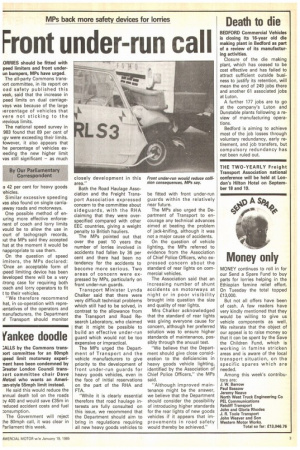Front under-run call
Page 5

If you've noticed an error in this article please click here to report it so we can fix it.
By Our Parliamentary Correspondent
.ORRIES should be fitted with peed limiters and front underun bumpers, MPs have urged. The all-party Commons trans;ort committee, in its report on oad safety published this veek, said that the increase in peed limits on dual carriagevays was because of the large percentage of vehicles that vere not sticking to the previous limits, The national speed survey in 983 found that 89 per cent of igv were exceeding their limits, lowever, it also appears that he percentage of vehicles ex:eeding the new higher limit vas still significant — as much Is 42 per cent for heavy goods 'ehicles.
Similar excessive speeding as also found on single carrialeway roads and motorways. One possible method of enuring more effective enforcenent of coach and lorry limits vould be to allow the use in ourt of tachograph records, put the MPs said they accepted hat at the moment it would be nappropriate to use them.
On the question of speed imiters, the MPs declared: 'Once an acceptable form of ;peed limiting device has been leveloped there will be a very :trong case for requiring both :oach and lorry operators to fit t to their vehicles.
"We therefore recommend hat, in co-operation with reprePentatives of the operators and nanufacturers, the Department af Transport should monitor
fankee doodle
;ALLS by the Commons trans)ort committee for an 80mph ;peed limit motorway experiment have been condemned by 3reater London Council trans)ort committee chair Dave Netzel who wants an Amerimn-style 55mph limit instead.
He said this would reduce the annual death toll on the roads ay 400 and would save £35m in reduced accident costs and fuel -.;onsumption.
The Government will reject he 80rriph call, it was clear in Parliament this week. closely development in this area."
Both the Road Haulage Association and the Freight Transport Association expressed concern to the committee about sideguards, with the RHA claiming that they were overspecified compared with other EEC countries, giving a weight penalty to British hauliers.
The MPs pointed out that over the past 10 years the number of lorries involved in accidents had fallen by 36 per cent and there had been no tendency for the accidents to become more serious. Two areas of concern were expressed by MPs, particularly on front under-run guards.
Transport Minister Lynda Chalker said that there were very difficult technical problems which still had to be solved, in contrast to the allowance from the Transport and Road Research Laboratory, who claimed that it might be possible to build an effective under-run guard which would not be too expensive or impractical.
The MPs urged the Department of Transport and the vehicle manufacturers to give priority to the development of front under-run guards for heavy goods vehicles, even in the face of initial reservations on the part of the RHA and FTA.
"While it is clearly essential therefore that road haulage interests are fully consulted on this issue, we recommend that the Department should aim to bring in regulations requiring all new heavy goods vehicles to be fitted with front under-run guards within the relatively near future.
The MPs also urged the Department of Transport to encourage any technical advances aimed at beating the problem of jack-knifing, although it was not a major cause of accidents.
On the question of vehicle lighting, the MPs referred to evidence from the Association of Chief Police Officers, who expressed concern about the standard of rear lights on commercial vehicles.
The Association said that an increasing number of shunt accidents on motorways at night or in poor visibility brought into question the size and quality of rear lights.
Mrs Chalker acknowledged that the standard of rear lights was giving everyone cause for concern, although her preferred solution was to ensure higher standards of maintenance, possibly through the anuual test.
"We believe that the Department should give close consideration to the deficiencies in heavy goods vehicle lighting, identified by the Association of Chief Police Officers," the MPs said.
"Although improved maintenance might be the answer, we believe that the Department should consider the possibility of introducing higher standards for the rear lights of new goods vehicles if it appears that improvements in road safety would thereby be achieved."














































































